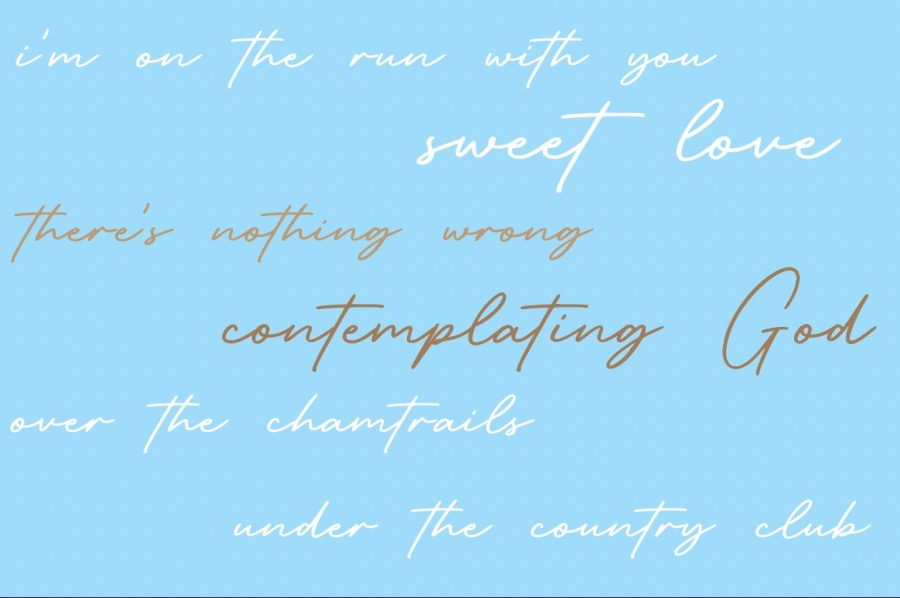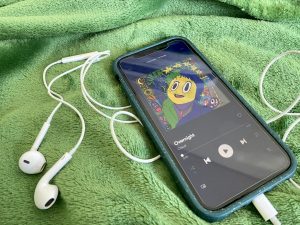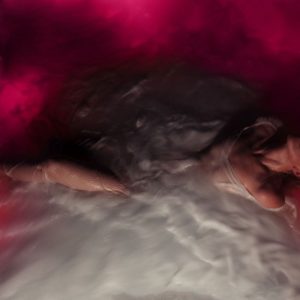Album review: “Chemtrails Over the Country Club”
March 26, 2021
If Elvis Presley and Marilyn Monroe had a kid in the 21st century, it would be Lana Del Rey. She’s as American as they come and “Chemtrails Over the Country Club,” her latest album released March 19, embodies nothing less than her patriotic aesthetics of the past 10 years, but this time with more intention.
American iconography and devotion have always been central to the character of Lana Del Rey. She writes about being “American made” on 2019’s “Venice B—-,” being proud like an American on her appropriately titled 2012 track, “American,” falling asleep in an American flag on 2012’s “Cola,” and other songs from her discography.
First entering the business under the name Lizzy Grant, her sound was inspired by her trailer park home, experiences in boarding school and rebellious teenage years. Her struggles as an artist have never been much of a part of her sound — until now.
After some time in the industry, she changed her name to Lana Del Rey and her look followed. From straight blond short hair Grant evolved into a ‘60s inspired, old Hollywood look. Her early music and accompanying videos were high budget, bringing fantasy and glamour.
Today, Del Rey’s music videos are homemade, similar to her breakthrough track “Video Games,” which she shot and directed herself.
“Chemtrails Over the Country Club” speaks to Del Ray’s former persona, Lizzy Grant, not Lana Del Rey. And before anything, the album demonstrates that she is a songwriter. Coined by many as a “pop-poet,” her sound has always been lush; it’s vintage, yet new, and depressing.
But is Grant a pop artist? In the mid 2010s when Tumblr inspired Gen Z’s music taste, she was lumped with other “indie” artists at the time. This includes the likes of the Arctic Monkeys, the 1975 and Marina and the Diamonds.
You can give all the credit to Grant for pioneering the sounds Billie Eilish, Lorde and Melanie Martinez rely on. These artists, emerging during the end of the last decade, employ the same pop melodies and deep lyricism as Grant that so many can relate to. These female personas as “women of depth” have grown in popularity in recent years in comparison to the industry’s traditional “plant” pop girl.
In 2014, Rolling Stone called Grant “a mystery that 10,000 tortured think pieces have failed to solve.” With that, there’s no more need for analysis on her musical character and identity.
“Born to Die” and “Paradise” were cinematic, no matter what the critics say. “Summertime Sadness” played at Jay Gatsby’s parties, after all.
Del Rey explores Americana further with folk songs different than the usual “sad girl” genre critics limit her to. Pitchfork recites her younger music recipe as “sad girls + Americana + string sections + quotes from other famous songs.”
“Chemtrails” knows personal confessions, new bridges, long drum breaks and an airy head voice. This is Del Rey’s most vocally daring album by far.
“White Dress,” Del Rey’s choice for the first song on the album, gives 19-year-old Lizzy working as a waitress a chance to reflect on the career Lana Del Rey has created.
Her rushed lyric, “down at the men in music business conference,” speaks to how Del Rey as a young adult spent time in Orlando and Miami playing shows in search of fame. Not only is Del Rey vulnerable about her feelings toward fame in this line, she tries her hand at a jazzier execution in the lyric.
The third track, “Tulsa Jesus Freak,” showcases Del Rey’s vocals in a matter no different than her standard. It’s a ballad we can expect from the singer on any body of work. This song was originally named “White Hot Forever,” its catchiest lyric. “White Hot Forever” was also Grant’s first pick for an album name.
“Dark But Just a Game” is easily the most unique song on the album. Halfway in is a switch to a trip-hop beat we would typically get from Grant on her earlier albums, though the guitar is still there.
Compared to records like “Ultraviolence” and “Lust for Life,” “Chemtrails” is underwhelming in its heterogeneity. We know Grant can make a breakup song, a makeup song and everything in between, even for atypical love stories.
But, let’s consider that it’s hard to follow what Pitchfork would agree is her best album yet — “Norman F—ing Rockwell!” (A drastic change in opinion from the publication on the artist.)
The two albums share piano ballads, insights into Grant’s life and her truths about the media’s perceptions of her. She’s mature, risky and she’s got the help of Bleacher’s Jack Antonoff.
Del Rey’s questionable “question for the culture” Instagram post last year sparked controversy over the singer’s sentiments.
In the statement, her take is that other big female artists like Doja Cat, Ariana Grande, and Nicki Minaj have made hit songs talking about “being sexy, wearing no clothes, f—ing, cheating, etc” but have not faced the criticism she has.
From the beginning of her career, Del Rey was singing about these topics, but she faced a lot of backlash from music critics and had a low public opinion. She alludes to herself being the first to do this.
Track five, “Wild at Heart,” could have crept its way into NFR, showing the albums’ similarities. The song lacks the strong piano elements of Del Rey’s sixth album. Fans speculate it is a continuation of NFR’s “How to Disappear” because there are some cross references in lyrics about Sunset Boulevard.
This album is Lizzy Grant, but it’d be interesting to see an album from Elizabeth Woolwridge Grant. Maybe we can look forward to that on her next album, Rock Candy Sweet.















